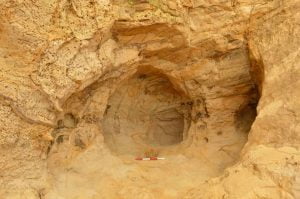Network Rail has announced that a team of rail workers working on repair work near Guildford have uncovered a small cave from the 14th century.
The cave is made up of sections ranging from 0.3m to 0.7m high and was discovered during work to repair the cutting.
The cave may once have been much larger, but this piece is the only one which survived the creation of the railway cutting in the early 1840s.
Initial findings by a specialist archaeological contractor suggest that it was a later medieval shrine associated with the early 14th century chapel of St Catherine, ruins of which are situated on the hill nearby.

There are a total of around seven or eight further niches, and experts have found evidence of writing and other markings on the ceiling
The cave is partially covered in black dust – this is believed to be soot from the lamps. The remains of two fire-pits were also found on the cave floor.
What did the officials say?
Mark Killick, Network Rail Wessex route director, said:
“This is an unexpected and fascinating discovery that helps to visualise and understand the rich history of the area.
“A full and detailed record of the cave has been made and every effort will be made to preserve elements where possible during the regrading of the delicate and vulnerable sandstone cutting.”
Tony Howe, historic environment planning manager and county archaeologist at Surrey County Council, said:
“The discovery of this cavern is tremendously exciting. It's very early in the process of understanding its full significance, but the potential for knowledge acquisition is huge.
“We're looking forward to learning an awful lot more about the site as studies progress.”
A spokesperson from Archaeology South-East said:
“The cave contained what appear to be shrines or decorative niches, together with carved initials and other markings. The old name for St Catherine's Hill is Drakehull ‘The Hill of the Dragon', so this has obviously been a site of ritual significance long before the construction of the church on the top of the hill in the late 13th century.
“Work is underway to analyse soot and charcoal found inside the cave, which will hopefully tell us more about how and when it was used.”
Where Next?
RailAdvent Plus
Get image downloads, Prints and Streaming Video
News Homepage
For the Latest Railway News
RailAdvent Online Shop
Framed Prints, DVD's / Blu-Ray's and more
LocoStop Community
Come and share your railway pictures
Mainline Steam Info
Upcoming mainline steam tours/loco movements
Network Rail
Visit their website